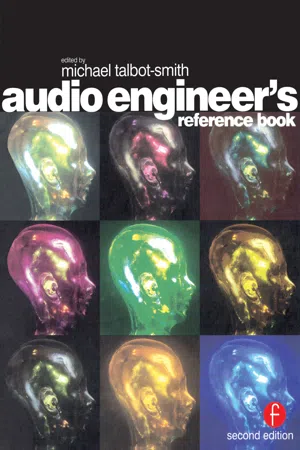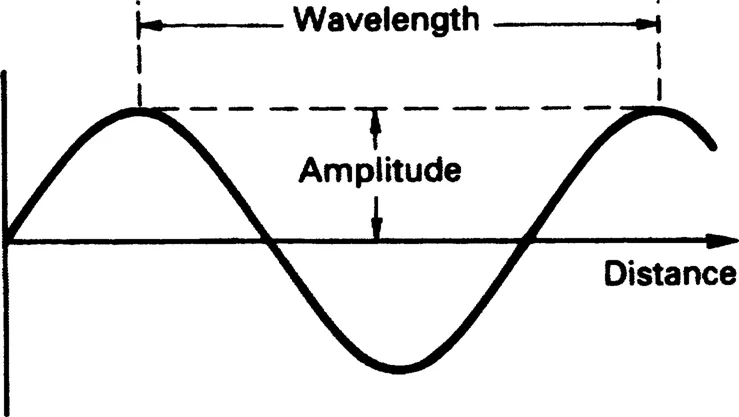
- 672 pages
- English
- ePUB (mobile friendly)
- Available on iOS & Android
eBook - ePub
Audio Engineer's Reference Book
About this book
An authoritative reference on all aspects of audio engineering and technology including basic mathematics and formulae, acoustics and psychoacoustics, microphones, loudspeakers and studio installations.
Compiled by an international team of experts, the second edition was updated to keep abreast of fast-moving areas such as digital audio and transmission technology. Much of the material has been revised, updated and expanded to cover the very latest techniques. This is a new paperback version.
Frequently asked questions
Yes, you can cancel anytime from the Subscription tab in your account settings on the Perlego website. Your subscription will stay active until the end of your current billing period. Learn how to cancel your subscription.
No, books cannot be downloaded as external files, such as PDFs, for use outside of Perlego. However, you can download books within the Perlego app for offline reading on mobile or tablet. Learn more here.
Perlego offers two plans: Essential and Complete
- Essential is ideal for learners and professionals who enjoy exploring a wide range of subjects. Access the Essential Library with 800,000+ trusted titles and best-sellers across business, personal growth, and the humanities. Includes unlimited reading time and Standard Read Aloud voice.
- Complete: Perfect for advanced learners and researchers needing full, unrestricted access. Unlock 1.4M+ books across hundreds of subjects, including academic and specialized titles. The Complete Plan also includes advanced features like Premium Read Aloud and Research Assistant.
We are an online textbook subscription service, where you can get access to an entire online library for less than the price of a single book per month. With over 1 million books across 1000+ topics, we’ve got you covered! Learn more here.
Look out for the read-aloud symbol on your next book to see if you can listen to it. The read-aloud tool reads text aloud for you, highlighting the text as it is being read. You can pause it, speed it up and slow it down. Learn more here.
Yes! You can use the Perlego app on both iOS or Android devices to read anytime, anywhere — even offline. Perfect for commutes or when you’re on the go.
Please note we cannot support devices running on iOS 13 and Android 7 or earlier. Learn more about using the app.
Please note we cannot support devices running on iOS 13 and Android 7 or earlier. Learn more about using the app.
Yes, you can access Audio Engineer's Reference Book by Michael Talbot-Smith in PDF and/or ePUB format, as well as other popular books in Technology & Engineering & Acoustical Engineering. We have over one million books available in our catalogue for you to explore.
Information
1 Basic Principles
DOI: 10.4324/9780080499581-1
- John Ratcliff
- Proprietor, The Television Training Company
- 1.1 Mathematics, formulae and equations
- 1.2 Units used in audio engineering
- Michael Talbot-Smith
- Consultant
- 1.3 The physics of sound waves
- J. Patrick Wilson
- Lecturer in Electronics, Keele University
- 1.4 The hearing process
- Louis D. Fielder
- Principal Staff Engineer, R&D and Business Development, Dolby Laboratories Inc
- 1.5 Perceptual audio coding
- Glynne Parry
- Senior Calibration Engineer, CEL Instruments Ltd
- Richard Tyler
- Chief Engineer, CEL Instruments Ltd
- 1.6 Noise measurement
- Michael Gayford
- Former Consultant (Deceased)
- 1.7 Electromechanical analogies
- Roger Derry
- Audio and Broadcast Consultant
- 1.8 Introduction to digital audio
1.1 Mathematics, formulae and equations
1.1.1 SI units
The four fundamental SI units are length, mass, time and electric current.
Length (L) The unit of length is the metre (m). One metre is 1 650 763.73 wavelengths in a vacuum of the radiation corresponding to the transition between the levels 2p10 and 5d5 of krypton-86.
Mass (M) The unit of mass is the kilogram (kg). One kilogram is the mass of the international prototype held by the Bureau International des Poids et Mesures, Paris.
Time (T) The unit of time is the second (s). One second is the duration of 91 926 131 770 periods of radiation corresponding to the transition between two hyperfine levels of the ground state of caesium-133.
Electric current (I) The unit of electric current is the ampere (A). One ampere is the current that, flowing in two infinitely long conductors of negligible cross-section spaced apart by one metre in a vacuum, will produce a force of 2 × 10−7 newtons per metre (N/m) between them.
1.1.2 Derived SI units
Velocity (V) Velocity is the distance/time in metres/second (m/s).
Acceleration (a) Acceleration is the rate of change of velocity. It is given in metres per second (m/s2).
Force (F) The unit of force is the newton (N). One newton will accelerate a mass of 1 kg by 1 m/s2.
Work or energy (W) The unit of work is the joule (J). One joule of work is done when one newton of force moves through one metre in the direction of the force.
Power (P) The unit of power is the watt (W). Power is the rate at which work is done: one joule of energy expended in one second requires one watt of power.
Charge (Q) The unit of charge is the coulomb (C). One coulomb is the quantity of electricity passing through a conductor when one ampere flows for one second.
Potential Difference (V) The unit of potential difference is the volt (V). One volt of potential difference exists between two points if one joule of work is done in transferring one coulomb of charge from one point to the other.
Resistance (R) The unit of resistance is the ohm (Ω). One ohm is that resistance in which a current of one amp generates energy at the rate of one joule per second.
Capacitance (C) The unit of capacitance is the farad (F). A capacitor of one farad will raise the potential between its plates by one volt with the addition of one coulomb of charge (Q = CV).
Magnetic flux (Φ) The unit of magnetic flux is the weber (Wb). When a conductor experiences flux changing at one weber per second a potential difference of one volt is produced across the ends of the conductor.
Flux density (B) The unit of flux density is the tesla (Wb/m2). The flux per square metre at right angles to the field is the flux density. Frequently quoted as webers per square metre: B = φ/a (Wb/m2).
Inductance (L) The unit of inductance is the henry (H). A closed circuit has an inductance of one henry when a potential difference of one volt is produced by a rate of change of current of one ampere per second.
Pressure (P) Unit of pressure is the pascal (Pa): one pascal is one newton per square metre (N/m2).
Frequency (f) The unit of frequency is the hertz (Hz). Frequency is the inverse of time (1/s). It is defined as the number of waves passing a fixed point in one second.
Wavelength (λ) Wavelength is the distance between successive points (e.g. crests) on successive waves (see Figure 1.1). Wavelength, velocity and frequency are related by the formula v = fλ.

Angle (Θ) Defined as the radian (rad). Two radii of a circle at an angle of one radian will cut an arc equal to the radius of the circle at the circumference. 27π radian = 360°. 1 radian = 57.3°.
Permeability (μ) The permeability of space (μ0) is the ratio of the flux density (B) to the magnetizing force (H) i...
Table of contents
- Cover Page
- Half-Title Page
- Title Page
- Copyright Page
- Table of Contents
- Preface to first edition
- Preface to second edition
- List of contributors
- 1 Basic Principles
- 2 Acoustics and acoustic devices
- 3 Recording and reproduction
- 4 Digital equipment
- 5 Studios and their facilities
- 6 Distribution of audio signals
- 7 Miscellaneous topics
- Index